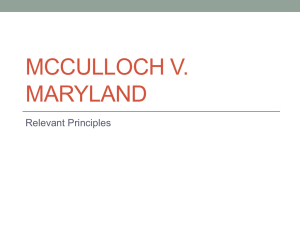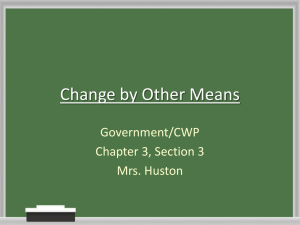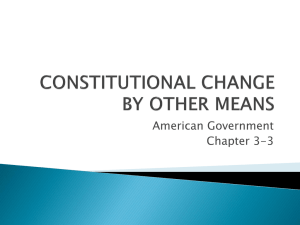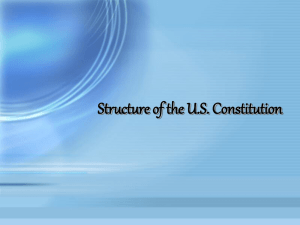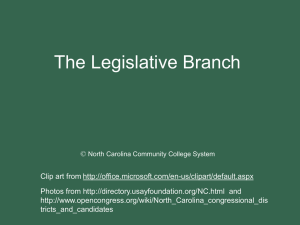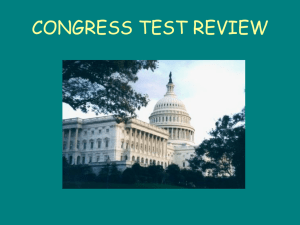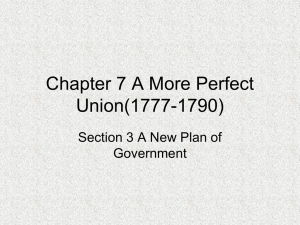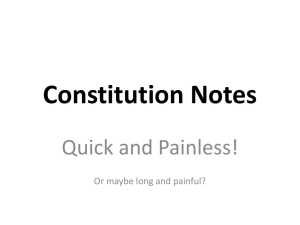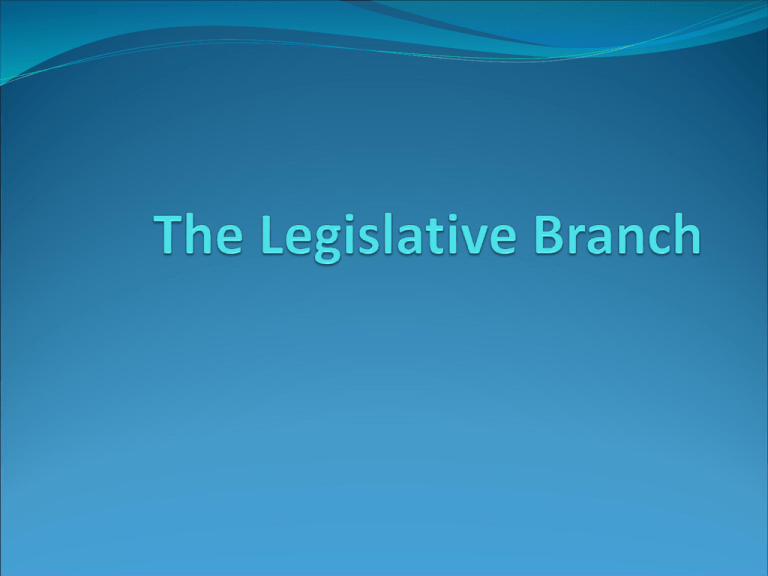
Local Legislative Branch
City Council
Country Council
City Council
Districts:
Maritime’s City Councilmember
District 2 Brandon M.
Scott
Brandon.Scott@baltimor
ecity.gov
State Legislative Branch
MARYLAND GENERAL ASSEMBLY
Two Parts:
House of Delegates
State Senate
Maritime’s State Senator
NATHANIEL J.
McFADDEN
Democrat, District 45
nathaniel.mcfadden@
senate.state.md.us
Maritime’s Delegates
State Delegates (District 45):
Talmadge Branch
Cheryl D. Glenn
Hattie N. Harrison – died this year,
replaced by Nina R. Harper
ARTICLE 1 of the Constitution –
Federal Legislative Branch
Congress
Two parts: House of Representatives and
Senate
Proposes and votes on laws to be sent to
the Executive Branch
Can override a presidential veto with a
2/3rds vote
Legislative Branch
Breakdown
House of
Representatives
Senate
Starts any bill having
Gives advice and
to do with revenue
(taxes)
Can impeach the
president and judges
if they violate the law
consent on treaties
Approves
presidential
appointments,
including judges
Conducts
impeachment trials
Maritime’s U.S. Senators
US Senators:
Barbara A. Mikulski - www.mikulski.senate.gov
Benjamin L. Cardin - www.cardin.senate.gov
Maritime’s U.S.
Representative
US Representative
(Maryland District
2):
C. A. Dutch
Ruppersberger
http://dutch.house
.gov
How a Bill becomes a Law
http://www.youtube.com/watch?v=mEJL2Uuv-oQ
…or doesn’t.
http://www.youtube.com/watch?v=uf2q66G3lmM&fea
ture=related
Key Principles
Federalism – roles of government are divided up between
the different levels of government
National Supremacy – the federal government shares
powers with the state/local governments, but the federal
government has more power and can override the
state/local government.
Commerce Clause - Refers to Article 1, Section 8, Clause 3
of the U.S. Constitution, which gives Congress the power
“to regulate commerce with foreign nations, and among
the several states, and with the Indian tribes.”
Elastic Clause – Refers to Article 1, Section 8, Clause 18 of
the U.S. Constitution, which gives Congress the power “to
make all Laws which shall be necessary and proper for
carrying into Execution the foregoing Powers, and all other
Powers vested by this Constitution in the Government...”
Key Cornell Notes
Key Idea
Definition
Interstate Economic activity involving
Commerce more than one state.
Implied
Powers
Powers that belong to
Congress even though it is
not directly stated in the
Constitution
McCulloch v. Maryland (1819)
A landmark decision by the Supreme court.
Said two main things:
First, the Constitution grants to Congress implied
powers for implementing the Constitution's express
powers, in order to create a functional national
government. Second, state action may not impede
valid constitutional exercises of power by the Federal
government.
Summary of the Decision
Gibbons v. Ogden (1824)
The Supreme Court determined that the commerce
clause of the Constitution grants the federal
government the power to determine how interstate
commerce is conducted.
So, because Gibbons had a license to operate from the
federal government, the state of New York could not
deny him the right to operate.
The commerce clause and the supremacy clause gave
the federal government the power to regulate the
shipping commerce, and not to have the state overrule
its regulations.
1. Which part of the U.S. Constitution was a basis for the decision in
McCulloch v. Maryland?
a.
The due process clause
b.
The establishment clause
c.
The equal protection clause
d.
The elastic clause
2. Which of these was an effect of the Supreme Court decision in McCulloch
v. Maryland?
a.
It guaranteed the right to an attorney in criminal cases
b.
It allowed individual states to tax the federal government
c.
State laws that conflicted with federal law became unconstitutional
d.
Congress had only those powers that were stated in the Constitution
3. Study the headline below and answer question 3.
Supreme Court Declares Restrictions on Election Ads Unconstitutional
The Supreme Court’s ruling in this situation is an example of:
a.
Judicial review
b.
Federalism
c.
Popular sovereignty
d.
Majority rule
1. Which part of the U.S. Constitution was a basis for the decision in
McCulloch v. Maryland?
a.
The due process clause
b.
The establishment clause
c.
The equal protection clause
d.
The elastic clause
2. Which of these was an effect of the Supreme Court decision in McCulloch
v. Maryland?
a.
It guaranteed the right to an attorney in criminal cases
b.
It allowed individual states to tax the federal government
c.
State laws that conflict with federal law became unconstitutional
d.
Congress had only those powers that were stated in the Constitution
3. Study the headline below and answer question 3:
Supreme Court Declares Restrictions on Election Ads Unconstitutional
The Supreme Court’s ruling in this situation is an example of:
a.
Judicial review
b.
Federalism
c.
Popular sovereignty
d.
Majority rule
Key Cornell Notes
Key Idea
Definition
Interstate Economic activity involving
Commerce more than one state.
Implied
Powers
Powers that belong to
Congress even though it is
not directly stated in the
Constitution
Bills of Attainder
A bill of attainder is an act of a legislature declaring a
person or group of persons guilty of some crime and
punishing them without privilege of a judicial trial.
Bills of attainder are expressly banned by the United
States Constitution.
Ex Post Facto Laws
An ex post facto law (Latin for "from after the
action“ ) is a law that makes actions that were
committed before the enactment of the law illegal.
Ex post facto laws are expressly forbidden by
the United States Constitution in Article 1, Section 9,
Clause 3.
Filibuster
A filibuster is a tactic used to prevent a measure from
being brought to a vote, usually when a senator
attempts to delay or entirely prevent a vote on a bill by
extending the debate on the measure.
The rules permit a senator, or a series of senators, to
speak for as long as they wish and on any topic they
choose, unless "three-fifths of the Senators duly
chosen and sworn“ (usually 60 out of 100 senators)
brings debate to a close.
War Powers
War powers are divided. The constitutional principle
of checks and balances requires the President and
Congress to work together when taking the nation to
war.
Congress has the power to officially declare war and
raise an army while the President is the Commander in
Chief of the military. But it is often unclear which
branch has MORE power than the other when
disagreements happen.
War Powers Resolution, 1973
The War Powers Resolution states that the President’s
power as Commander-in-Chief to introduce U.S. forces
into hostilities [armed conflict] can only be used after
war is declared or in a national emergency.
It specifically requires that the President to consult
[talk] with Congress before introducing American
forces into hostilities and report on their progress
every 60 days.
IMPEACHMENT
Definition: Congress can remove a president from office
for “high crimes and misdemeanors”
This is an example of:
Checks and Balances or Federalism?
IMPEACHMENT
Definition: Congress can remove a president from office
for “high crimes and misdemeanors”
This is an example of:
Checks and Balances
**Congressional (legislative branch) power to impeach
is a check on President (executive branch)**
Impeachment of Bill Clinton
Impeachment: Congress can remove a president from
office for “high crimes and misdemeanors”
In 1998 Bill Clinton was impeached by the House of
Representatives
The charges against him were perjury, obstruction
of justice, and malfeasance (wrongful conduct) in
office
Charges came out of a sex scandal
What led to Clinton’s
impeachment:
•He was having an affair with
Monica Lewinsky in White House
•Lewinsky told a close friend
about her affair with president
•Her friend secretly began taping
their conversations
•She gave the tapes to the
newspapers and story broke
Impeachment: Congress can remove a president from
office for “high crimes and misdemeanors”
Clinton denied the sexual affair in court (pre-trial
investigation)
After that, the House of Representatives voted to
impeach Clinton
But…there is another chamber in the Congress
that must vote, what is it?
The U.S. Senate must vote (67%) to approve the charges,
and then a president is removed
- 55 senators voted
“Not Guilty”
-45 Senators voted
“Guilty”
Therefore, Clinton
was acquitted of the
charges and allowed
to continue being
president
Impeachment vote in the
U.S. Senate

